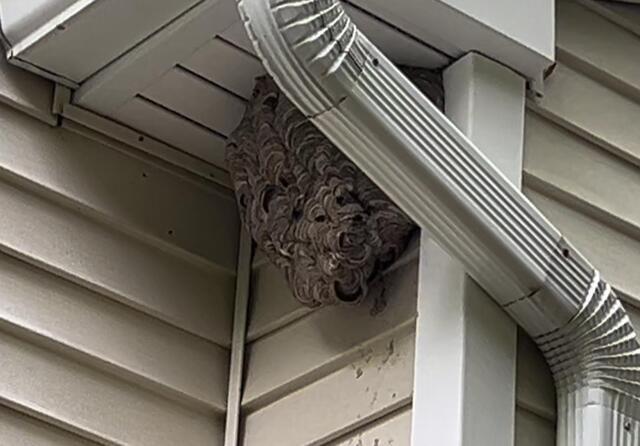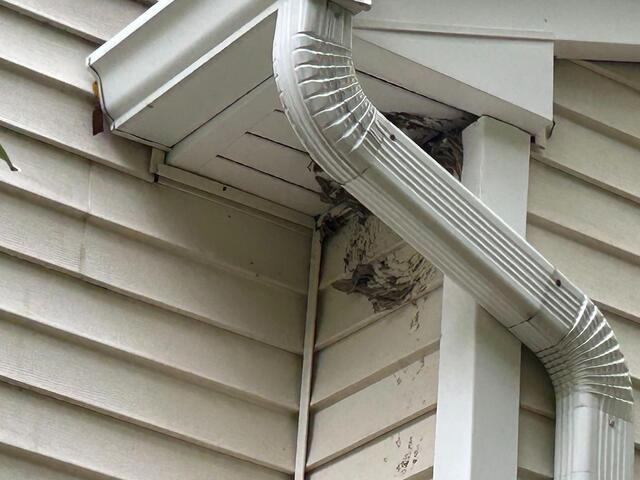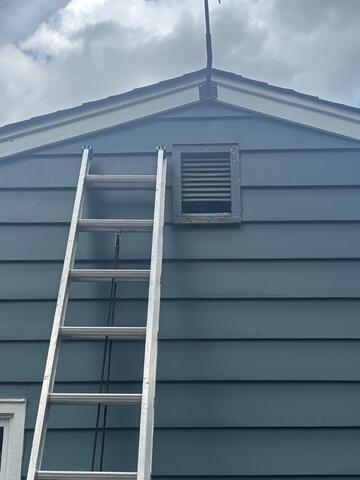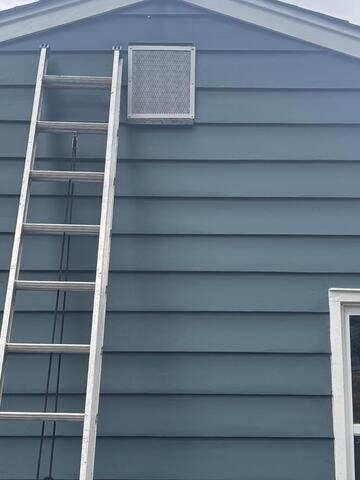Cowleys Pest Services Before & After Photos
Click on a photo to enlarge.
Excluding the Squirrels from the Gable Vent in Morganville, NJ
This homeowner in Morganville, NJ, had an infestation of squirrels in their attic. After a thorough inspection, we discovered that they were entering the home via the gable vent. Squirrels infesting a home via the gable vents is very common as over time, the gable vents get weathered and squirrels (and other nuisance wildlife) have no problem ripping away these vents to find shelter inside a home. After installing our retrieval devices, in a short amount of time, we successfully and safely retrieved all the squirrels and relocated them to a new, humane location.
Before we left, we removed the broken gable vent, disinfected the attic, and installed a louvered vent guard. This material is made out of heavy-duty Galvannealed steel (which means it won't rust) and is customized to accommodate vents of all shapes and sizes. Now that it is installed, squirrels and other nuisance wildlife will no longer be able to enter the attic through the gable vent.
Unsuspected Homeowner Gets Stung by Bald-Faced Hornet in Morganville, NJ
As this customer in Morganville, NJ was working out in his backyard, he noticed a rather large hornets nest on the side of his home! Since he is a Home Protection Plan customer, he called up Cowleys, and we were sent out. After equipping our protective bee suits we took a closer look at these insects and identified them as bald-faced hornets. Bald-faced hornets are social stinging insects that have white markings on their face. They're EXTREMELY aggressive and territorial. So aggressive that if anyone or anything comes within close proximity of their nest, they will attack!
Using our extendable pole, we liberally treated the nest with a knockdown aerosol application and then a knockdown dusting product. Both of these treatments will exterminate the bald-faced hornets quickly. After some time had passed, we removed the nest and disposed of it properly. Lastly, we applied a liquid non-repellant residual to the area where the nest was. This will neutralize any bald-faced hornets that return to this area and prevent them, and any other stinging insect, from building a new nest.
Mice Living in Basement Insulation in Marlboro, NJ
We were sent out on a service call to a new customers home in Marlboro, NJ, to treat for mice. The owner was wondering why she had mice to begin with because she regularly deep cleaned her home. Well, about 30 yards away from the property was a heavy wooded area with a lot of water and, after a thorough inspection of the home, there were a lot of gaps around the basement vents. The mice were coming from the woods and, since it was getting cold outside, making there way into the basement!
As we inspected the basement, we found a ton of mice droppings and tunnels throughout the insulation. Mice will often tunnel in the insulation to create a warm nesting place. First, we carefully removed all the mice droppings. Next, we installed several rodent bait stations throughout the basement and along the exterior of the home.
Afterward, we stuffed all the openings around the basement vents with chew-proof, stainless steel mesh and then sealed them with a waterproof, premium adhesive. Lastly, we scheduled several follow up visits to replenish the bait in the rodent bait stations and to monitor the mice activity.
Denying Squirrels Access to the Gable Vents in Marlboro, NJ
After finding a squirrel in his attic, this homeonwer in Marlboro, NJ called Little Rascals for help and we were sent out. When we arrived, we first inspected the exterior to find out exactly how the squirrel was getting into the home. Moments into our inspection, we found out! The gable vent was wide open, damaged, and exposed. Nuisance wildlife infesting a home via the gable vents is very common. Over time, the gable vents get weathered and raccoons, squirrels, birds, and bats have no problem ripping away these vents to find shelter inside a home - which is exactly what happened here!
To retrieve the squirrel, we installed a positive set over the gable vent and temporarily enclosed the area with hardware cloth. A positive set is comprised of a nose cone, which will guide the squirrel into a two-gaited, heavy-duty device. This is called a positive set, because we are positive that the squirrel will have no other way to exit except through our device! We also placed several baited devices nearby. A short while later, we successfully & safely retrieved the squirrel and relocated it to a new, humane environment.
To prevent any future nuisance wildlife intrusions, we installed Pest-Blok over the gable vent. Pest-Blok doesn't restrict the airflow to the attic, undergoes a silicone-protected polyester coating process that makes it last longer, and guards the home against all nuisance wildlife.
Raccoons Wreak Havoc in Attic in Carteret, NJ
These homeowners in Carteret, NJ found themselves with a raccoon infestation in their attic. Our wildlife technicians quickly trapped and relocated the trespassing animals. Unfortunately, as often happens, the attic insulation was contaminated and destroyed. Raccoons, with their razor-sharp claws, will shred through the insulation and use it as nesting material. Also, they deposit their wastes and urine all over it. Once this happens, the saturated insulation is not salvageable. There is no choice but to remove and replace it with new insulation.
A Cowleys installation crew arrived to make the attic as good as new. Our goal was to remove any traces that the attic was once a home to wildlife. After removing the contaminated insulation, we sanitized and deodorized the entire attic to remove any and all “evidence” that there once was a raccoon infestation, including the pungent smells left behind. After a wildlife infestation, it is critical to have the attic thoroughly cleaned — not only to remove dangerous pathogens but also to remove any remnants of an infestation, which can be an attractant for other raccoons and wildlife to follow. Wildlife cleaning and sanitation is not a DIY weekend project. This stuff is dangerous! When droppings are disturbed, airborne waste particles are released into the air that can be breathed in and cause serious, chronic respiratory infections. Animals droppings in an enclosed area are a serious bio-hazard. This waste should only be removed by someone who is trained in using proper protective equipment.
After the cleaning and sanitation, we installed our blown-in cellulose insulation. This insulation has excellent thermal properties and, because it is blown-in rather than cut to size like fiberglass batts, all areas of the attic, down to the smallest nooks and crannies, are insulated. This insulation will pay for itself over time with reduced heating and cooling bills.
The installation crew was especially proud of this project. We successfully transformed an attic that was destroyed by invading wildlife into a clean, beautiful, functional space that will improve the home’s energy efficiency.









